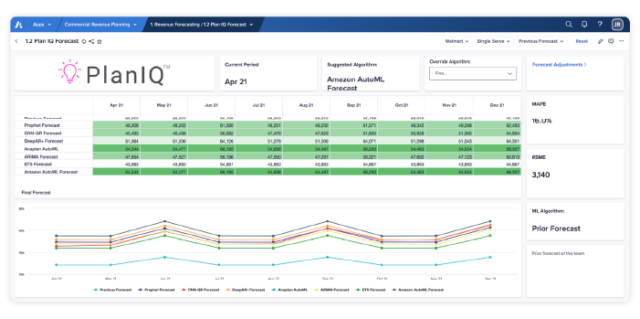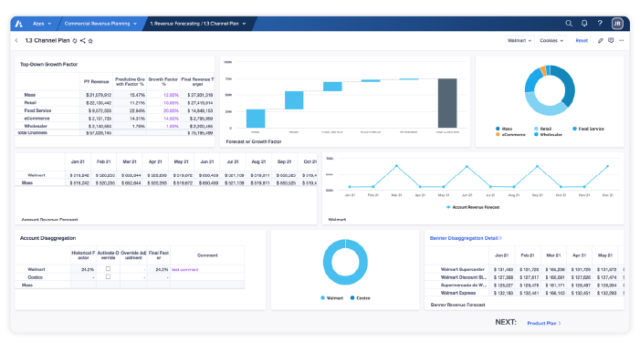If you’re a revenue planning manager at a consumer packaged goods (CPG) company, in normal years, planning and maximizing revenue performance for your set of products is complicated—but not unsolvable. You know what worked the previous year in terms of what specific products, in what variations of features or packaging, sold in which stores, at what prices, with what discounts and store fees, to yield a given level of profits.
Looking to boost topline revenue in the coming year, you tweak each of your numbers a bit to reflect changing economic conditions, maybe try some experiments like new flavors or advertising campaigns, and watch what happens.
When something upsets that whole system, last year’s numbers are useless for making predictions for the next year. That upsetting “something” could be COVID or a supply-chain shock, such as the cargo ship stuck in the Suez Canal. Or a longer-term change in consumer behavior, such as online shopping or low-carb diets.
How do you revise your revenue plan for success?
With traditional planning applications, that’s difficult. The various revenue drivers, such as consumer confidence, inflation, interest rates, fickle consumer tastes, and the effects of weather on commodity prices are all baked into the predictions these applications generate. It can be very hard to tease out specific factors to see how each affects overall top-line revenue.
That means you have to plan by guesswork or time-consuming, labor-intensive manual calculations. As a result, you may price products too low, and leave money on the table; too high, and lose business; not ship in time and leave shelves empty; advertise in the wrong channels; or simply fail to anticipate consumer demands. Meanwhile, retailers are pushing back on shelving fees and their own profit margins because retailing is a highly competitive, low-margin business.
Get a clear view of drivers of revenue performance
The new Anaplan for Commercial Revenue Planning solution offers clarity. It adds seamless access to leading external indicators and second- and third-party data sources to all the usual internal parameters within a CPG manufacturer’s control. Then it helps apply those insights to the company’s annual operating plan, and thus, the operational plans in trade, marketing, and sales.
The solution offers four ingredients that together provide step-by-step support to optimize all the varied aspects of the consumer revenue problem, for product, sales, and finance teams. These steps are:
- Understand drivers of revenue performance.
- Allocate investments to influence outcomes.
- Evaluate multiple scenarios in real time.
- Optimize and automate revenue performance.
In each installment of this blog series, we’re going to examine a different ingredient of the CRP solution. Here, we’re starting with the most basic need: Understanding drivers of revenue performance.
Set controls for “optimize”
Drivers of revenue performance can be imagined as a set of slider bars like the picture quality controls on your camera, a set of parameters that contribute to an overall experience. These drivers include:
- Raw material prices
- Energy prices (affecting the costs of transport and running factories)
- Labor costs and availability
- Consumer confidence levels
- Interest rates
- Product variations (size, packaging, flavors, accessories, and so forth)
- Pricing
- Coupons and other discounts
- Advertising and other promotions
- Shelving or slotting fees to retailers
- Sales channels (retailers, pop-ups, mail order, direct online sales, third-party online stores such as Chewy.com, and more)
- Shifting consumer preferences
With most other solutions, it’s hard to track these drivers separately, much less figure out how to find new combinations that improve revenue. Typically, users can only work with their company’s own first-party customer data or, at most, second-party data.
The Anaplan solution enhances these standard internal data sources with external signals, such as fluctuations in the GDP, unemployment rate, interest rate, or consumer confidence levels, which are all important guides for how much people are willing to spend (and therefore, whether they’ll prefer the premium or bargain version of a product).
The Anaplan solution lets the user enter all the relevant variables and build plans either top-down from revenue targets or bottom-up from current or projected sales data, predictively supplying forecast estimates to fill in the picture. It can accommodate a wide range of predictive algorithms, ranging from Amazon AutoML forecasts to the ones built into Anaplan PlanIQ. Or you can manually override the forecast algorithms to fit your business’s unique needs.
AI isn’t coming to the rescue
Because commercial revenue planning is a complex problem, some forward-looking companies have started trying to solve it with artificial intelligence and data science.
The problem is, those AI-driven projects are not generally part of any systematic planning process. Typically, they’ll generate an in-depth study of a situation at one point in time, for one brand, in a single geography, for a single retail chain (say, jarred salsa in Los Angeles for the Vons chain). It’s essentially a piece of scientific research, a report of a one-time experiment that won’t necessarily generalize to future usage or other products or audiences. And unless an AI algorithm is kept updated, it won’t continue to learn from ongoing situations.
By contrast, Anaplan for Commercial Revenue Planning continually gives you new insights in real time, easily extensible to other products and scenarios. This is because the AI built into the solution constantly learns from the inputs you give it and proactively offers updates to the plan.
When revenue managers can clearly see and understand the factors that drive their products’ performance, it’s easier to start allocating their investments where they make the biggest difference.
Before committing to a specific plan, they can test and compare different scenarios, such as what happens if they introduce a new product narrowly (say, in just a few markets, or in chains that focus on a specific demographic), versus rolling out to all channels at once. Or if the price of a key ingredient in a frozen meal goes up, should they increase the meal’s price or merely shift promotional dollars to a more profitable product for a quarter or two.
That kind of “sandbox” experimentation is important because even a plan that maximizes profits under current conditions may not work as well if things change midyear. For example, if cybercriminals cause sudden shortages of gasoline or meat – events that would have seemed like mere science fiction a few years ago. Smart revenue planners will be prepared for such shifts because they’ve plotted out the best responses.
In future blog posts, we’ll delve more deeply into how Anaplan can help product managers evaluate scenarios and allocate spending – and how it can automate and optimize the promotion schemes that yield maximum topline revenue while requiring less manual effort and offering greater real-time responsiveness.







